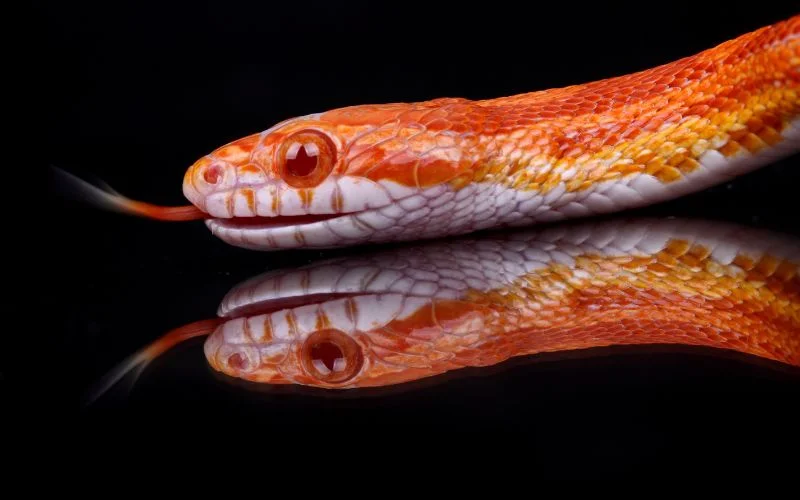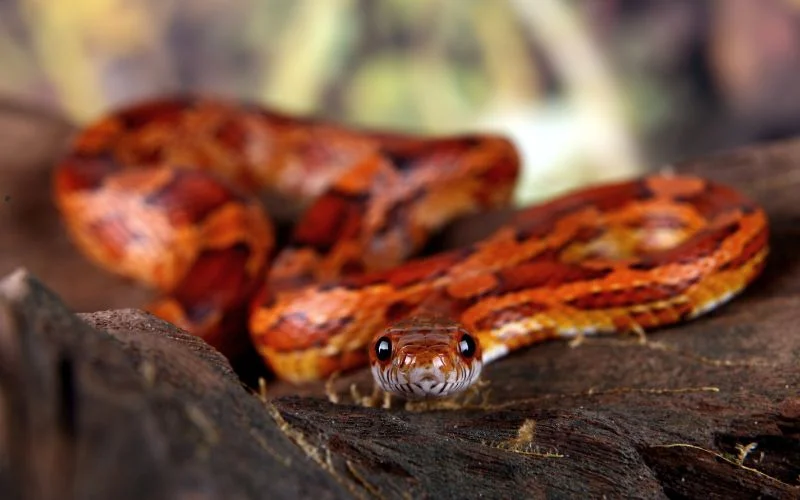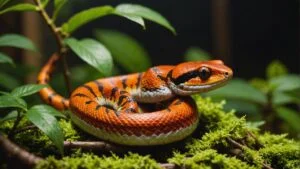They offer a blend of docility and eye-catching beauty when considering a corn snake as a pet. You’ll need to consider their health and temperament and the care each color morph demands. Creating the perfect habitat involves more than just a tank; it’s about maintaining the right temperature, humidity, and enrichment to keep them engaged. But how do you guarantee your corn snake thrives, and what should you watch for in their behavior? Let’s explore the essentials to keep your new pet happy and healthy.
Key Takeaways
- Corn snakes are popular, low-maintenance pets with varied color morphs.
- Ensure a secure enclosure with proper substrate, hiding spots, and enrichment.
- Maintain a temperature gradient of 70-90°F and humidity at 40-50%.
- Feed appropriately-sized thawed rodents using tongs to mimic natural hunting.
- Handle gently, limit sessions to 10-15 minutes, and avoid post-feeding or shedding periods.
Choosing the Right Corn Snake


When selecting the right corn snake, please consider its health, temperament, and age. You’ll want to ensure the snake appears active and alert, with clear eyes and smooth scales. Check for any signs of illness or distress, like lethargy or wheezing, which could indicate underlying health issues.
Color morphs are another exciting aspect to ponder. Corn snakes come in various colors and patterns, from classic orange and red to exotic morphs like albino or lavender. These variations can add a unique aesthetic to your pet, but remember that some morphs might come with specific care requirements.
Age considerations are also important. Younger snakes are generally more adaptable and easier to handle but require frequent feeding and monitoring.
On the other hand, older snakes are often more resilient and have established eating habits, making them slightly easier to care for. However, they might be less tolerant of frequent handling.
Setting Up the Habitat
Select the right enclosure to create a comfortable habitat for your corn snake. A glass tank works well, but ensure a secure lid to prevent escapes. For an adult corn snake, a tank size of at least 20 gallons is recommended, though bigger is always better to provide ample space for exploring. If you’re housing a juvenile, a 10-gallon tank will suffice temporarily.
Next, focus on substrate options. Aspen shavings are popular due to their absorbency and ease of cleaning. They also allow the snake to burrow, mimicking natural behaviors. Alternatively, you can use cypress mulch, which retains moisture well, or even paper towels for a simple, easy-to-clean option, especially for quarantine or young snakes. Avoid cedar and pine substrates as they contain oils harmful to your snake.
To help your snake feel secure, hide spots on the tank’s warm and cool sides. You can use commercially available hides or create your own from items around the house. Include a large water dish for your snake to soak in, and consider adding branches or rocks for enrichment. You’ll ensure your corn snake thrives in its new home by thoughtfully setting up the habitat.
Temperature and Humidity
Maintaining proper temperature and humidity levels is vital for your corn snake’s health and well-being. Corn snakes thrive in a habitat where the temperature mimics their natural environment. Aim for an ideal temperature gradient within the enclosure: a warm side between 85-90°F and a cooler side around 70-75°F. This allows your snake to regulate its body temperature by moving between warmer and cooler areas.
Humidity control is just as significant. Corn snakes prefer a humidity level of 40-50%. Too much humidity can lead to respiratory issues, while too little can cause shedding problems. To maintain the right humidity, mist the enclosure lightly and ensure proper ventilation.
Here’s a quick reference table to help you manage temperature and humidity:
| Aspect | Ideal Range |
|---|---|
| Warm Side Temp | 85-90°F |
| Cool Side Temp | 70-75°F |
| Humidity Level | 40-50% |
Use digital thermometers and hygrometers to monitor these conditions accurately. Place one thermometer on each side of the enclosure and a hygrometer in the center. By maintaining these optimal conditions, you’ll ensure your corn snake stays healthy and comfortable.
Feeding Your Corn Snake
Feeding your corn snake properly is crucial for its health and longevity. The primary diet for corn snakes consists of appropriately sized rodents, such as mice or rats. It’s important to offer prey about the same width as the snake’s widest part to guarantee easy digestion.
Dietary variety can play a role in keeping your corn snake interested in its meals. Occasionally, you can introduce other prey items like chicks or quail to provide some variation. However, rodents should remain the staple of their diet.
Feeding frequency is another critical aspect to take into account. Younger corn snakes require more frequent meals, typically every 5-7 days, due to their rapid growth rate. As they mature, you can reduce the frequency to once every 7-10 days for sub-adults and once every 10-14 days for adults. Always monitor your snake’s weight and adjust feeding schedules accordingly.
Thaw frozen prey properly before offering it to your snake. Using tongs to present the prey can also help mimic natural hunting behaviors and ensure safe feeding.
Handling and Socialization
After ensuring your corn snake is well-fed, it’s important to focus on proper handling and socialization to build trust and reduce stress. Start by letting your snake acclimate to its environment for a week or so before attempting any handling. This period helps reduce stress and makes your snake comfortable with its new home.
Approach it slowly and confidently when you’re ready to handle your corn snake. Gentle interactions are key. Use both hands to support its body, ensuring you’re not squeezing too tightly. Always hold your snake close to the ground or over a soft surface to prevent injury if it slips from your hands.
Limit handling sessions to 10-15 minutes initially, gradually increasing the time as your snake becomes more accustomed. Consistent, gentle interactions will help in building trust. Avoid handling your snake right after feeding or during shedding periods, as these times can be particularly stressful for them.
Pay attention to your snake’s body language; signs of stress include hissing, rapid tongue flicking, and attempting to escape. Focusing on stress reduction and gentle interactions will create a positive experience for you and your corn snake.
Health and Wellness
Maintaining your corn snake’s health and wellness involves regular monitoring and preventive care to detect any issues early. One key aspect to watch is the shedding process. Typically, a healthy corn snake sheds its skin in one piece. You should provide a humid hide in their enclosure to facilitate this process. If you notice incomplete sheds, it could indicate an issue with humidity levels or underlying health problems.
Parasite prevention is another critical aspect of your corn snake’s wellness. Internal and external parasites can pose significant health risks. To minimize the risk, regularly clean the enclosure and replace the substrate. When introducing new items or food, ensure they’re parasite-free. It’s also wise to schedule periodic veterinary check-ups for fecal tests to detect internal parasites early.
Observe your snake’s behavior and physical condition regularly. Look for signs such as unusual lethargy, changes in appetite, or respiratory issues like wheezing. These can be early indicators of health problems. Acting quickly at the first sign of trouble can significantly affect your snake’s well-being.
Common Behavioral Issues


Sometimes, you might notice that your corn snake exhibits puzzling or concerning behaviors. One common issue is escape attempts. Corn snakes are natural escape artists, so if your snake frequently tries to wiggle out of its enclosure, it’s crucial to check for gaps or insecure lids. Ensure the habitat is secure and the environment is stimulating enough to engage them.
Another behavior to watch for is a defensive posture. If your snake suddenly becomes more defensive, hissing, or striking when you approach, it may feel stressed or threatened. This could be due to a new environment, improper handling, or health issues. Ensure that their habitat is appropriately sized and temperature-controlled, and always handle your snake gently and confidently to reduce stress.
Sometimes, a corn snake may refuse to eat, which can be alarming. This can be due to stress, illness, or shedding. Monitor your snake closely and consult a vet if the issue persists.
Understanding these common behaviors and addressing them promptly will help you create a secure and stress-free environment for your corn snake.
Breeding Basics
Breeding corn snakes can be a rewarding experience if you understand the basic requirements and processes involved. First, you must ensure your corn snakes are healthy and mature enough for breeding. Typically, they should be at least two years old and in good health.
The mating season usually starts in the spring, so you’ll want to introduce the male and female during this time. Before introducing them, brumation (a cooling period) can help stimulate breeding behaviors. This involves lowering their enclosure temperature for a few months.
Once the mating season begins, place the male in the female’s enclosure and observe their interactions. Successful mating often involves the male courting the female through body movements and tactile cues. After mating, the female will need a suitable laying area, like a nesting box filled with moist substrate.
She’ll lay her eggs about 30 to 50 days post-mating. The incubation period for corn snake eggs is typically around 60 to 70 days, with temperatures between 80-85°F. During this time, keep the humidity levels high to ensure proper development.
Conclusion
Taking care of a corn snake can be a rewarding experience if you pay attention to their specific needs. From choosing the right snake to setting up the perfect habitat, ensuring proper temperature and humidity, and feeding them correctly, you’ll keep your pet happy and healthy.
Regular handling and being mindful of their health can prevent common issues. With the right care, your corn snake will thrive and become a treasured part of your life.


